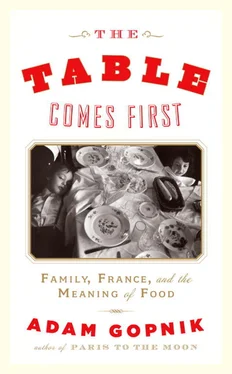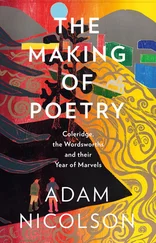It is surely somewhere here that the real difficulty about the whole vexed meat-eating question lies. Not how we think abstractly about the rights of meat-eating, but how we actually feel when we eat meat. In that most evil of all films, the Goebbels-produced Nazi-era “documentary” The Eternal Jew , there’s a bizarre, interminable sequence—obscenely heralded by a title page warning off “sensitive German viewers”—of kosher butchery, taken during the Polish invasion, in which a cow, its throat cut, is bled to death, poor beast, and the indifference of the bearded Jewish butchers to the suffering is a sign of their evil indecency. Because they are cruel to animals (let us bracket, both on the page, and in our minds, whether kosher butchery is truly crueler than any other kind) we can be cruel to them: they don’t have the same feelings as the rest of us, either of empathy or of sensitivity. Exterminating them is not like exterminating people; it is like exterminating rats.
Of course, vegetarians are not Nazis—but there is a sense in which sensitivity to animals has nothing at all to do with any other ethical acquisition. People have, historically, as often used cruelty to animals as a justification for being cruel to people as they have as a reason for not being cruel to anything. See how they treat their horses, was one cry of the Mongols about their enemies. The path from sensitivity to the suffering of animals to sensitivity to the suffering of humans is, as a matter of plain fact, far from open or easy.
Our little dog, Butterscotch, lives for steak. It is the beginning and end of pleasure for her. Her nose quivers, her whole small fluffy body shakes, gripped by a primal hunger so intense that she can barely contain it. She smells steak and she does a sit, does another sit, tightening the first one—falls to the floor in a “down” and then does a head-down and a spin and a shake; her whole repertory of tricks, just to show how much she wants it and how eager she is to do anything she needs to do to get it. We slice it fine for her, and then watch her inhale it—well, she is a carnivore, a little wolf, not by sentiment but by genetics: isn’t her hunger for meat some sign that eating it is, not compulsory certainly, but hard to call evil in any recognizable sense? An appetite implanted so deep in our natures seems less of a sin and more of a scar—something that we just have , as part of living in the world we live in with the heritage we share, and that we can only improve by being certain that we are not cruel in its pursuit.
I don’t know; I shudder at the verdict of our descendants even as I recognize the carnivorousness of our animal natures. And I go on eating, and serving, steak.
In slicing the pommes soufflées , and readying the two Dutch ovens for their brief role as frying pots, I am aware that there is an element, what I believe could be called a “stark” element, of show, of carnival barkerishness, in the dish. This used to be part of the business of the chef—public amazement—which was then judged vulgar and largely banished. Or rather expelled to another world, to the nightly ribbon of spectacle. I wonder what you would make of cooks on cable television? What would you think—cook after cook, traveling and arguing and competing, making part of the public show things that were kept in the sanctity of the kitchen? Now, I am aware that for all that we have in common, you depended on servants a bit more than your writing quite likes to show. And nowhere more than in the pommes soufflées business—let’s be candid, your airily summoning up a plate of them does not mean that you are about to go off to the kitchen, Elizabeth, and make them. It means either that your cook has been busy or that you are imagining them, as eaten in Paris. One thing that separates our time from yours most firmly: there are no cooks outside the kitchen in yours. You mention famous chefs from time to time, but they belong to the distant and remote past.
So I wonder how you would feel about our cable carnival of cooking? Every night, there are competitions, tours, chef against chef, young cook against old cook—thirty minutes head-to-head. We are supposed to be disapproving, of course, and to see this as a degradation of the art. And the idea of food shows on television is a paradox that Chesterton could not have imagined: food watched , food that no one can taste or smell or eat. To be honest, while my taste for recipe books is insatiable, my appetite for cable cooking shows is very limited. The ideas take so long to blossom, the preparations so long to prepare, that I get impatient.
But there’s nothing really offensive or “off” about it: it celebrates, in however debased and diminished a form, an idea of expertise, of craft, which is the one thing that is vanishing from our world. Mario and the Iron Chefs are there because they have finish—they’re good at what they do, rather than being freakishly who they are. Being good at what you do is so odd and rare a thing in life now that just showing someone being good at something is enough to hold several million people. Even the contest shows make at least a pretense at excellence: the viewer can’t taste the food but Padma can, and the alarming sternness of the judgment at least simulates, pantomimes, the idea of something being at stake in the act of craft. (One can’t imagine a Top Artist show because the standards of what is considered art and poetry are by now so essentially whimsical or arbitrary that no one could agree: being good at rhyme or drawing has only a tangential relation to being famous for being a poet or an artist.) At least, when a chef makes something, she is making something. It’s either tasty or it isn’t, and the taste rises from the practical mastery of a craft. This is surely the reason that people respond with such excitement even to things that seem to me tedious, like Dancing with the Stars or American Idol —the “cruelty” to the contestants isn’t cruelty at all; it may be the only time many people in the audience have seen a craft standard enforced with craft severity: there really is and isn’t a right way to tango, as there is a right way and wrong way to make pommes soufflées .
Oh, yes, the pommes soufflées . Well, I did them, ever so carefully, slicing and prefrying and then true frying… and they failed, totally and utterly. Not a single blossom or blister or even a hint of puffing and expanding. Obviously I had the width wrong, or the heat wrong, or the order wrong. There is a reason that French restaurants don’t do them; they’re too much trouble for too little reward. The reward is just the look, the puff, the hot air inside—the potato is still the same.
The infusion of air is always a sign of elegance, in your day as in ours. How many things in the kitchen involve simply beating in air: meringues, whipped cream, pommes soufflées , soufflés themselves. It is, perhaps, no accident that we call a book cover’s blurb a “puff.” We condemn hot air even as we eat it. Air is the forgotten medium of cooking.
Did I say they all failed? In truth, there was a single pomme soufflé —one slice had popped and blossomed amid the rest that had decided to remain potato chips. I looked at it and put it aside, and then fed it to the little dog.
Very best,
Adam
12. What Do We Write About When We Write About Food?
RECENTLY, THERE WAS an exchange in the pages of The Times Literary Supplement about the presence, and the propriety, of recipes in novels, and I intend to settle the questions that have arisen there in the American way, right now, and for good. There are four kinds of food in books: food that is served by an author to characters who are not expected to taste it; food that is served by an author to characters in order to show who they are; food that an author cooks for characters in order to eat it with them; and, last (and most recent), food that an author cooks for characters but actually serves to the reader.
Читать дальше












